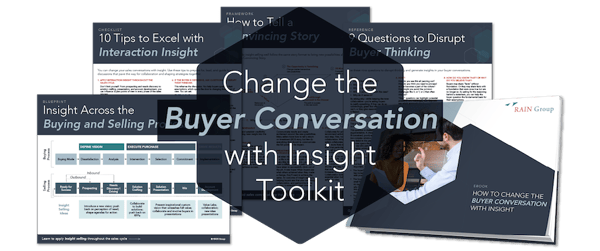Differentiation often starts with marketing, but it truly comes alive in the selling process. Even if your company’s products and services are superior to all others, this means nothing if you can’t convey that to your buyers. Differentiating in sales is more than a good pitch—you need to differentiate in the right areas, adapt to your buyer’s needs, and build value.
Differentiation is one of the three legs of your value proposition—where your offerings resonate, differentiate, and substantiate with buyers. If your offerings can easily be substituted, buyers will either pressure you on price or get them elsewhere. In the past, differentiation was considered solely based on an organization’s offerings. Today, we know that sellers themselves need to differentiate in the selling process.
The Differentiating Factor in Sales
When RAIN Group analyzed just over 700 B2B sales made to buyers who represent $3.1 billion in annual purchases from industries with complex sales, we learned what sales winners do differently in the selling process compared to the sellers who didn’t win, but came in second place.
One area we studied was buyers’ perceptions of what they believe led them to buy from the winners. Overall, we studied 42 factors, three of which focused on differentiation. They were:
- Overall value from the company was superior to other options.
- Company offers products and services that are superior to other options.
- Seller differentiated their products and services from the other available options.
These differentiation factors dominated the top of the list: they represent three of the top four of 42 factors! Differentiation in the selling process is not only helpful, but also of the utmost importance if a seller wants to win.
How to Differentiate in Sales
Here are seven tips to differentiate in the selling process.
1. Differentiate in the Right Areas
Sales winners differentiate in four areas:
- Yourself: What’s the value in working with you? How can you help a buyer achieve their goals?
- Your offerings: What makes your products and/or services stand out from others on the market? What’s the differentiating factor?
- Your company: How reputable is your company? What kind of results have you gotten working with other buyers?
- The eventual results the buyer can achieve: What does success look like for your buyer? Does it mean less hassle for them? A good ROI? Something else?
Depending on the buyer, some areas will be more important than others. It’s up to the seller to find out which. I’ll cover components of all four in the remaining tips.
2. Create Distinction and Scarcity
Differentiation has two major components: overall distinction and perception of scarcity.
- Ask a buyer why they chose one provider over another after they make a purchase and there’s usually more than one single reason. There's a collection of distinctions that ultimately makes the winner stand out in the buyer’s mind. These reasons aren’t always consciously known to the buyer. But the sellers who win are often the ones who help buyers see what’s possible and bring new ideas to the table.
- When a buyer perceives that something is scarce, it stands out to them, and they tend to desire it more when it’s difficult to find.
Scarce, by the way, does not mean “unique.” Uncommon can be just as strong and is usually more believable. It’s typically more important to buyers to have expectations met in commonly discussed areas than it is to get something truly novel.
Many sellers promise quality, results, responsiveness, service, continuous improvement, and so on, but few deliver. Those who prove they can deliver well in these areas stand out. Often, this can be seen before the buyer even makes a purchase. Strong sellers assist buyers every step of the way, helping them understand the financial and emotional impact of their offering. Distinction starts by leading productive conversations with buyers.
3. Ditch the USPs
Many sellers are told they must build and practice perfect delivery of their Unique Selling Proposition, or USP. However, USPs don’t account for the buyer’s situation, and sellers rely too much on them late in the selling process.
Unique selling propositions are for the "wanna go out" early part of the selling process, not the "let’s get married" part that comes at the end. Often, USPs aren’t very unique anyway; one sounds much like the next. Many sellers overestimate the power of the pitch.
Most importantly, they’re often not the reason a buyer actually buys.
It’s far more important to understand your buyer's needs. If your USP helps you get a foot in the door, great. But you’ll also need to do your research and craft a compelling solution based on your market position, what happens if the buyer moves forward with you, and what happens if they don’t. This is why an understanding of storytelling is critical to the selling process: you’ll often only have seconds to get your story to stick in a buyer’s head.
Use USPs to set the table for ongoing discussion when you meet someone, but ditch them beyond the first conversation.
4. Proactively Reach Out to Buyers
If you wait for buyers to contact you, you’ll lose more sales than you win. The reason? If you’re not proactively looking for sales opportunities, you can guarantee that the buyers who reach out to you already have a solution in mind—and they’ve likely already made their own judgments and compared you to other organizations.
The earlier in the buying process you can reach buyers the better. Understand that other sellers will be reaching out to them as well, and you don’t want to be one of the last options they talk to. That’s why prospecting is an important part of succeeding in sales.
5. Tailor Your Conversations Based on Buyers' Experiences
Early in the selling process, sellers get asked, "How are you different?" Often, the answers aren’t that great. When you answer, remember that differentiation implies comparison. It’s up to the seller to find out, "In comparison to what?"
There are two important comparisons:
- How you’re different from the world. When a seller answers the question, this is where they tend to go, using a canned response of standard key points. You should have these at the ready, but you might not want to use them if you can get to #2.
- How you're different than their experience with people, products or services, and companies similar to yours. Few go here, but when they do, it makes it much more real for the buyer.
You can’t always know what buyers are thinking, but you can ask questions that grant insight into their experiences and what they value.
When you answer, you might say, "In my experience, how people perceive us as different depends on their experiences with others in our space. Let me ask you, then, what’s your impression of companies like ours? What have your specific experiences been like when working with them?"
Do this and you’ll create a conversation. The resulting conversation will be much richer than a rehearsed answer and will likely present additional areas in which you can separate yourself from your competition.
6. Practice What You Preach
Sellers should model the behavior they use to differentiate. Done well, this can create positive perceptions and reinforce stated value. For example, if a key point about your value and differentiation is responsiveness, be responsive. If you’re responsive in the selling process and the other sellers aren’t, the buyer will, by proxy, assign that value to your company. The other company’s delivery teams may claim to be responsive too, but you create the perception that your company is more responsive if you model the behavior and others don’t.
If one of your key points of value is providing ideas and advice to help buyers improve their businesses, do this in the selling process. If others don’t, they’ll perceive this value to be true about your company.
7. Differentiate Yourself–You Make a Difference
I mentioned this in #1 above, but it bears repeating: many sellers think that company and offerings are the most important areas for differentiation in the selling process, but differentiation of the seller themselves is just as important.
Not only are you important in winning the sale, you’re just as important for ongoing buyer loyalty. People are more willing to buy from you if they like you. Be genuinely helpful and reliable and you’ll find yourself winning more meetings—and more sales.
Our research found that the buyer’s experience in the buying process is just as predictive of ongoing loyalty as product or service satisfaction.
Differentiation as Sales Strategy
As a seller, you can’t afford to make the mistake of thinking your organization speaks for itself—YOU are speaking for your organization. Consider these areas of differentiation in your sales conversations and do your research to build an advantage for yourself and win more sales.
 Learn how to share new ideas, challenge thinking, and ask incisive questions with our free toolkit, How to Change the Buyer Conversation with Insight. Download now →
Learn how to share new ideas, challenge thinking, and ask incisive questions with our free toolkit, How to Change the Buyer Conversation with Insight. Download now →




